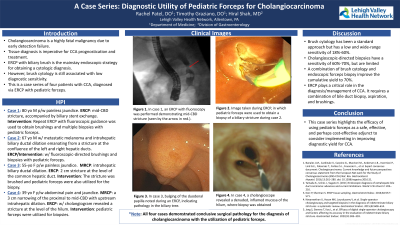Sunday Poster Session
Category: Biliary/Pancreas
P0101 - Case Series: Diagnostic Utility of Pediatric Forceps for Cholangiocarcinoma
Sunday, October 27, 2024
3:30 PM - 7:00 PM ET
Location: Exhibit Hall E

Has Audio
.jpg)
Rachel Patel, DO
Lehigh Valley Health Network
Coopersburg, PA
Presenting Author(s)
Rachel Patel, DO1, Timothy Graziano, DO2, Hiral Shah, MD3
1Lehigh Valley Health Network, Coopersburg, PA; 2Lehigh Valley Health Network, Allentown, PA; 3Lvhn, Center Valley, PA
Introduction: Cholangiocarcinoma (CCA) is a highly fatal malignancy with rising incidence, due in part to early detection failure. Tissue diagnosis is difficult but imperative for CCA prognostication and treatment planning. ERCP with biliary brush is the mainstay clinical endoscopic strategy for obtaining a cytologic diagnosis. Despite this, brush cytology is still associated with low diagnostic sensitivity. We present a case series of four patients with CCA, diagnosed via ERCP with pediatric forceps.
Case Description/Methods: Case 1: 80-year-old male with painless jaundice underwent an ERCP of a mid-common bile duct stricture, accompanied by biliary stent exchange. Prior cholangioscopic forceps biopsies and brushings were non-diagnostic. Repeat ERCP with fluoroscopic guidance, was used to obtain brushings and multiple biopsies with pediatric forceps. Case 2: 67-year-old male with metastatic melanoma with intrahepatic biliary ductal dilation emanating from a stricture at the confluence of the left and right hepatic ducts underwent an ERCP with fluoroscopic-directed brushings and biopsies with pediatric forceps. Case 3: 55-year-old female presented with painless jaundice. MRCP revealed intrahepatic biliary ductal dilation. ERCP revealed a 2 cm stricture at the level of the common hepatic duct. The stricture was brushed and pediatric forceps were also utilized for the biopsy. Case 4: 39-year-old female with abdominal pain and jaundice underwent a MRCP which showed a 3 cm narrowing of the proximal to mid-CBD with upstream intrahepatic dilation. An ERCP cholangiogram revealed a stricture at the level of the hilum, and pediatric forceps were utilized for biopsies. All four cases demonstrated conclusive surgical pathology for the diagnosis of CCA with the utilization of pediatric forceps.
Discussion: ERCP plays a critical role in the diagnosis and management of CCA. It often requires a combination of bile duct biopsy, aspiration, and brushings. Brush cytology has been a standard approach, but unfortunately with low sensitivity of 18% to 60%. Cholangioscopic-directed biopsies have a sensitivity of 60% to 70%, but are limited by endoscopists’ expertise, availability and cost of the procedure. When multiple methods are combined, such as combination brush cytology and endoscopic forceps biopsy, the cumulative yield improves to 70%. This case series highlights the efficacy of using pediatric forceps as a safe, effective, and perhaps cost-effective adjunct to consider implementing in improving diagnostic yield for CCA.
Disclosures:
Rachel Patel, DO1, Timothy Graziano, DO2, Hiral Shah, MD3. P0101 - Case Series: Diagnostic Utility of Pediatric Forceps for Cholangiocarcinoma, ACG 2024 Annual Scientific Meeting Abstracts. Philadelphia, PA: American College of Gastroenterology.
1Lehigh Valley Health Network, Coopersburg, PA; 2Lehigh Valley Health Network, Allentown, PA; 3Lvhn, Center Valley, PA
Introduction: Cholangiocarcinoma (CCA) is a highly fatal malignancy with rising incidence, due in part to early detection failure. Tissue diagnosis is difficult but imperative for CCA prognostication and treatment planning. ERCP with biliary brush is the mainstay clinical endoscopic strategy for obtaining a cytologic diagnosis. Despite this, brush cytology is still associated with low diagnostic sensitivity. We present a case series of four patients with CCA, diagnosed via ERCP with pediatric forceps.
Case Description/Methods: Case 1: 80-year-old male with painless jaundice underwent an ERCP of a mid-common bile duct stricture, accompanied by biliary stent exchange. Prior cholangioscopic forceps biopsies and brushings were non-diagnostic. Repeat ERCP with fluoroscopic guidance, was used to obtain brushings and multiple biopsies with pediatric forceps. Case 2: 67-year-old male with metastatic melanoma with intrahepatic biliary ductal dilation emanating from a stricture at the confluence of the left and right hepatic ducts underwent an ERCP with fluoroscopic-directed brushings and biopsies with pediatric forceps. Case 3: 55-year-old female presented with painless jaundice. MRCP revealed intrahepatic biliary ductal dilation. ERCP revealed a 2 cm stricture at the level of the common hepatic duct. The stricture was brushed and pediatric forceps were also utilized for the biopsy. Case 4: 39-year-old female with abdominal pain and jaundice underwent a MRCP which showed a 3 cm narrowing of the proximal to mid-CBD with upstream intrahepatic dilation. An ERCP cholangiogram revealed a stricture at the level of the hilum, and pediatric forceps were utilized for biopsies. All four cases demonstrated conclusive surgical pathology for the diagnosis of CCA with the utilization of pediatric forceps.
Discussion: ERCP plays a critical role in the diagnosis and management of CCA. It often requires a combination of bile duct biopsy, aspiration, and brushings. Brush cytology has been a standard approach, but unfortunately with low sensitivity of 18% to 60%. Cholangioscopic-directed biopsies have a sensitivity of 60% to 70%, but are limited by endoscopists’ expertise, availability and cost of the procedure. When multiple methods are combined, such as combination brush cytology and endoscopic forceps biopsy, the cumulative yield improves to 70%. This case series highlights the efficacy of using pediatric forceps as a safe, effective, and perhaps cost-effective adjunct to consider implementing in improving diagnostic yield for CCA.
Disclosures:
Rachel Patel indicated no relevant financial relationships.
Timothy Graziano indicated no relevant financial relationships.
Hiral Shah: Abbvie – Speakers Bureau.
Rachel Patel, DO1, Timothy Graziano, DO2, Hiral Shah, MD3. P0101 - Case Series: Diagnostic Utility of Pediatric Forceps for Cholangiocarcinoma, ACG 2024 Annual Scientific Meeting Abstracts. Philadelphia, PA: American College of Gastroenterology.
